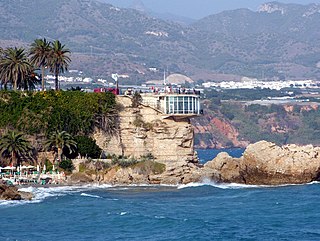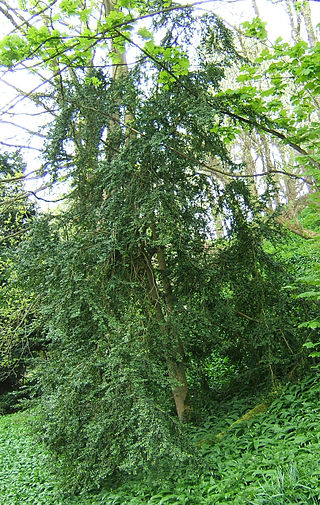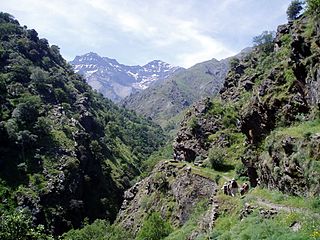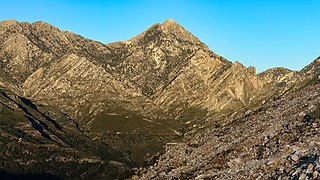
The province of Málaga is located in Andalusia, Spain. It is bordered by the Mediterranean Sea to the south and by the provinces of Cádiz to the west, Seville to the northwest, Córdoba to the north, and Granada to the east.

Buxus is a genus of about seventy species in the family Buxaceae. Common names include box and boxwood.

The Baetic System or Betic System is one of the main systems of mountain ranges in Spain. Located in the southern and eastern Iberian Peninsula, it is also known as the Cordilleras Béticas or Baetic Mountains. The name of the mountain system derives from the ancient Roman region of Baetica, one of the Imperial Roman provinces of ancient Hispania.

Canillas de Aceituno is a municipality in the province of Málaga in the autonomous community of Andalusia in southern Spain. It is located in the east of the province and is one of the municipalities comprising the comarca of Axarquia and the judicial district of Vélez-Málaga. It is a small village, located at the foot of the "La Maroma" mountains in Spain.

The Levante is a name used to refer to the eastern region of the Iberian Peninsula, on the Spanish Mediterranean coast. It roughly corresponds to the former Xarq al-Ándalus, but has no modern geopolitical definition. Rather, it broadly includes the autonomous communities of Valencia, Murcia, Catalonia, the eastern part of Castile-La Mancha, eastern Andalusia, southern Aragon (Teruel) and the Balearic Islands.

The Penibaetic System is the southernmost of the three systems of mountain ranges of the Baetic System in the southern Iberian Peninsula. It includes the highest point in the peninsula, 3,478 m high Mulhacén in the Sierra Nevada.

Alcaucin is a town and municipality in the province of Málaga, part of the autonomous community of Andalusia in southern Spain. It borders with the province of Granada. The municipality is situated approximately 54 kilometers to the city of Málaga. It is 507 km from the capital of Madrid. The name was derived from al-kautín, the Arabic of "the arches." It has a population of approximately 1,600 residents, partly living in the hamlet of Puente Don Manuel. Natives of the town are called Alcaucineños and have the nickname of tiznaos.

Canillas de Albaida is a town and municipality in the province of Málaga, part of the autonomous community of Andalusia in southern Spain. It has a population of approximately 800 residents. The natives are called Canilleros. The village is one of several typical Andalucian pueblos blancos which ring the edge of the national parks.

Cómpeta is a town and municipality in the comarca of Axarquía, and province of Málaga, part of the autonomous community of Andalusia in southern Spain. The municipality is situated approximately 18 kilometres from the coast, and 52 kilometres from Málaga, the provincial capital. It is situated at 638 metres above sea level in the foothills of La Maroma. The population is spread over the southern slopes of the Sierra de Almijara.

Sedella is a town and municipality in the province of Málaga, part of the autonomous community of Andalusia in southern Spain. The municipality is situated approximately 54 kilometres from the provincial capital of Málaga, 23 from Vélez-Málaga and 8 from Canillas de Aceituno. The Sierras of Tejeda, Almijara and Alhama Natural Park is just north of the village.

Arenas is a municipality in the province of Málaga located in the autonomous community of Andalusia in southern Spain. It is situated in the comarca of Axarquía. By way of road it is located 12 kilometers from Vélez-Málaga, 50 km from Málaga and 577 km from Madrid. It is located northwest of the Axarquia, between the sierras of Tejeda and Almijara and the Castle of Bentomiz.

Los Bermejales Reservoir is a reservoir in Arenas del Rey, province of Granada, Andalusia, Spain. It is fed by streams from the Sierra de Almijara mountains in the Sierras of Tejeda, Almijara and Alhama Natural Park and is the source of the Cacín River.

The Sierras of Tejeda, Almijara and Alhama Natural Park is a protected area in the Spanish provinces of Málaga and Granada. It contains the Sierra de Tejeda and Sierra de Almijara mountains. The park is mountainous and is partly covered by pine forests at the lower levels, while typical Mediterranean vegetation is found higher up. There is a large number of endemic species.

The Sierra de Tejeda is a mountain range in the Penibaetic System of mountains between the provinces of Málaga and Granada in Spain. Together with the Sierra de Almijara to the east and the Sierra de Alhama to the west it constitutes a limestone massif that acts as a physical border between the two provinces, separating the Axarquía from the depression of Granada. The mountains contain the Sierras of Tejeda, Almijara and Alhama Natural Park.

The Cacín River is a river in Andalusia, Spain. It is supplied by streams flowing north from the Sierra de Almijara and Sierra de Tejeda into the Granada Basin. The river originates in the Los Bermejales Reservoir, and flows north to join the Genil river. In its upper reaches it runs through a deep gorge that holds traces of Paleolithic human occupation.

Navachica is a mountain in the Province of Málaga in southern Spain, the highest peak in the Sierra Almijara.

The Cerro del Lucero, also known as El Lucero, Raspón de los Moriscos or Cerro de los Moriscos, is a mountain in the Alhama de Granada municipality of the Province of Granada in southern Spain, in the Sierra Almijara.

The Sierra de Almijara is a mountain range in the provinces of Granada and Málaga in southern Spain. The rocks are mainly marble, giving a white or gray color to the narrow ridges and deep ravines. The range is mostly protected by the Sierras of Tejeda, Almijara and Alhama Natural Park.

The Chíllar River is a river in the east of the Province of Málaga, Spain. It originates in the Sierra de Almijara and enters Mediterranean Sea just west of the town of Nerja.

Maytenus senegalensis, also known as arto, arto negro or espino cambrón in Spanish is a thorny shrub of the Celastraceae family. Endemic to Ibero-Africa, it is an endangered species and listed as vulnerable. It contains cathinone and cathine.






















